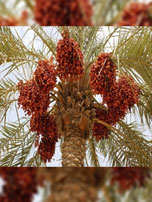SHAHEED KARTAR SINGH SARABHA AYURVEDIC MEDICAL COLLEGE & HOSPITAL
Affiliated to Guru Ravidas Ayurved University, Hoshiarpur Punjab
Affiliated to Guru Ravidas Ayurved University, Hoshiarpur Punjab

Botanical Name : Phoenix dactylifera Linn.
Family : Palmae; Arecaceae.
Introduction :
Latin name: Phoenix = Gk. name of the tree; sylvestris = sylvisticus = of the wood lands.
Names in different Indian languages :
English : Edible date palm
Hindi : Khajur
Kannada : Khajuri
Malayalam : Ittapana
Sanskrit : Khajur
Tamil : Perichchankay
Telugu : Karjurakaya
Unani : Khurmaa, Khajuur, Chhuharaa
Scientific Classification : Date palms belong to the family Arecaceae (formerly Palmae). The common date palm is classified as Phoenix dactylifera, the sugar date palm as Phoenix sylvestris, the blue date palm as Phoenix zeylanica, and the pygmy date palm as Phoenix roebelenii.
Synonyms :
Kharjoor; Kharaskandho, Dushpradharsha, Durarooha, Nihshreni, Kashaya,Yavaneshta, haripriya.
Varieties :
Phoenix sylvestris
English name: Date.
Botanical Description :
It is a tree growing to a height of 12 to 15 mtrs. Its trunk is straight, grayish and the stalk of the leaves is attached to the trunk.
Leaves – 15 to 17.5 cm. long. Leaflets – 15 to 30cm. long and 2.5 cm. wide, pointed at the tips and arranged opposite to each other. There is one leaflet at the lip of each teal. Each leaf has at its base a thorn which is 10 cm. long. Only the female khajoor plant bears fruits.
Fruits – 2.5 to 3 cm. long, round and yellowish in colour. On ripening, they become red in colour. The fruit contains an oblong seed, flowers bloom in summer and later on fruiting occurs. Juice obtained horn its trunk is called khajuri. When the juice ferments after some time, it becomes an alcoholic beverage. Jaggary is prepared from its juice.
Types: 1) Khajoor 2) Pindakharjoor (fruit is big, fleshy. Gostan khajoor). Besides, other varieties like Rajakharjoori, Madhukharjoorl. Bhookharjoort, Sulemani khajoor etc. are also described In the nighantus.
Habitat :
All over India. Pindakharjoor is basically from North Africa, Egypt. Syria and Arabasthan. But now a days, it is also cultivated in Punjab and Sindh.
Chemical composition :
Pindakharjoor contains iron, mucilagenous substance and calcium.
Properties :
Guna: snigdha, guru;
Rasa: madhur;
Virya: sheeta;
Vipaka: madhur;
Dosha: vatapittashamak.
External uses :
Roots are analgesic. In toothache, decoction of the roots is used for gargling or root powder is applied on the tooth,
Internal uses :
It alleviates vata and acts as a nervine tonic and a tranquilizer. It is useful in fainting, giddiness, intoxication, lower backache and sciatica. It reduces polydipsia, vomiting, diarrhoea, weakness of the heart, cough, asthma, hiccups, seminal weakness and dysuria. In fever, its sherbat is given. Its sherbat is also useful in various debilitating diseases like tuberculosis and fever. Kharjuri is useful in tuberculosis.
Dose :
Fruits – 5 to 7; juice – 50 to 100 ml.
Date Palm :
Date Palm, common name for several related trees found in tropical regions. The common date palm is native to northern Africa, southwest Asia, and India and is cultivated extensively in hot, dry regions throughout the world. The trunk is straight and rough and grows to a height of up to 18 m (up to 60 ft). It bears a head of waxy-green, barbed leaves, about 3 m (about 9 ft) long, and a number of branching spikes that, on the female tree, bear 200 to 1,000 dates each. A cluster of dates weighs up to 12 kg (up to 25 lb), and the annual yield of a single tree may reach 270 kg (600 lb). The tree begins to bear about the eighth year, reaches maturity at 30 years, and begins to decline at about 100 years. From earliest times, fertilization has been aided by cutting off the male flower cluster just before the stamens ripen and suspending it among the flowers of the female tree.
In many parts of northern Africa, Iran, and Arabia, date palms are the main wealth of the people, and dates are the chief article of food. The fleshy part of the fruit contains about 58 percent sugar and 2 percent each of fat, protein, and minerals. Leaf stalks are used for basketry and wickerwork, leaves are woven into bags and mats, and fiber from both is made into cordage.
Another species, the sugar date palm, or toddy palm, is cultivated in India for its sap. The sap may be boiled down to form jaggery, or gur, a crude sugar; or it may be used as a fresh beverage, or to make palm wine, from which arrack, a rumlike liquor, may be distilled. Date palms are often cultivated in the southern United States for ornamental effect in regions too cool for the fruit to ripen. The blue date palm grows in clumps and has silvery blue foliage; the pygmy date palm is a dwarf species that is also popular in the north as a greenhouse plant or houseplant.
